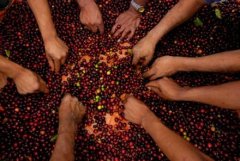Coffee Bean Type Introduction Gene Mutant

From left to right: Kenya round beans, elephant beans, Kenya AA
Pointed Bourbon (Bourbon Pointu): found in Bourbon Island in 1810, beans changed from round to pointed, with only half the caffeine content, but in small amounts, weak and extremely precious (mostly cultivated in the laboratory).
Elephant bean (Maragogype, or Elephant Bean): Tibica's best-known variety of beans, first discovered in 1870 in the Maragogype bean-producing region of the state of Bahia in northeastern Brazil, is at least three times larger than the average Arabica, hence the name. The taste of elephant bean is poor in low altitude area, but it has better flavor at high altitude, mild sour taste and sweet fragrance.
Geisha (Geisha): a derivative of the Tibika family, it was exported from the Geisha Mountains of southern Ethiopia in 1931 (Geisha is synonymous with Japanese geisha). After being unknown in many countries, it was transplanted to Panama in the 1960s and did not begin to win cup tests until 2005.
Kenyan "SL28" and "SL34": the bourbon line, screened and cultivated by French and British missionaries and researchers in Kenya in the early 20th century, has adapted to Kenya's high-concentration phosphate soil for a century, giving birth to Kenyan characteristics of sour elves; top Kenyan coffee comes from these two varieties, but it loses its flavor when transplanted elsewhere.
Yellow bourbon (Bourbon Amarello, or Yellow Bourbon): a bourbon variety endemic to the Brazilian state of Sao Paulo, where the coffee fruit does not turn red and is orange when ripe. It was later found that the pericarp of other local bourbon-derived varieties also turned yellow.
Kaddura (Caturra): a single genetic variant of bourbon, discovered in Brazil in the 1950s. The long-term ability and disease resistance are better than bourbon, and no shade tree is needed; the flavor is equal to or slightly worse than bourbon.
Pacas (Pacas): the bourbon variety found in El Salvador, which was transplanted into El Salvador coffee farmer Pacas in 1935, yielded more results than other coffee trees of the same species in 1956. Experts were asked to identify and confirm that there was a genetic mutation.
The bourbon variety, which was first discovered in Costa Rica in the Villa Sarchi:1960 era, has often appeared on the cup test list of excellence in recent years.
Important Notice :
前街咖啡 FrontStreet Coffee has moved to new addredd:
FrontStreet Coffee Address: 315,Donghua East Road,GuangZhou
Tel:020 38364473
- Prev

Indonesia's top coffee bean Celebes Tongkonan
Celebes Tongkonan national treasure beans are the top coffee beans produced by Toraja on the island of Sulawesi, Indonesia. The reason why they are rare is that the annual output is less than 1000 barrels (1.5kg per barrel of raw beans). Most of the output is monopolized by European traders. It is used by the Indonesian royal family and EU officials as exclusive top beans for gifts. There is little circulation on the market, and a batch of them flowed into Taiwan in 2009.
- Next

Varieties of coffee beans flat beans, round beans and elephant beans of coffee
Usually we buy coffee beans, one side is flat, there is a crack in it, this is the coffee cherry in the two seeds (that is, coffee beans) side; this kind of normal beans, we call flat beans (or lentils, flatbeans). Some berries contain only one seed (for unknown reasons), which takes up the internal space of the whole berry and looks like two smaller flat beans.
Related
- Guji coffee producing area of Guji, Ethiopia: Humbela, Shakiso, Wulaga
- What is the most expensive variety of Qiloso in BOP multi-variety group?
- How to store the coffee beans bought home?
- Why are Yemeni coffee beans so rare now?
- Ethiopian Sidamo all Red Fruit Sun Sun Santa Vini Coffee beans
- SOE is mostly sour? What does it mean? Is it a single bean? what's the difference between it and Italian blending?
- Is Italian coffee beans suitable for making hand-brewed coffee?
- How to choose coffee beans when making cold coffee? What kind of coffee beans are suitable for making cold coffee?
- Just entered the pit to make coffee, what kind of coffee beans should be chosen?
- Can only Japan buy real Blue Mountain Coffee? What are authentic Jamaican Blue Mountain coffee beans?

